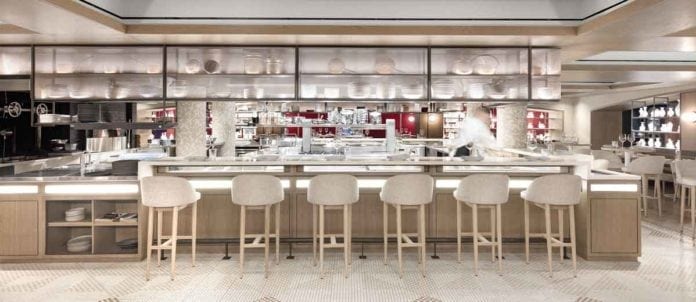The level of disruption currently faced by the foodservice industry means new restaurants are putting increased focus on developing a distinct, individual identity.
“Everyone is working toward trying to make that memorable and unique experience because, at the end of the day, this is an industry with a crazy amount of competition,” says Andrew Oliver, president and CEO of Toronto-based Oliver & Bonacini Hospitality (O&B). “People are looking for that hugely experiential [occassion]that they can not only share with the people they’re having dinner, lunch or breakfast with at the time, but share with the world via social media.”
There’s a lot that goes into successfully creating a space that evokes this kind of reaction, especially if you hope to achieve an air of authenticity. For O&B, this process typically begins with an opportunity and some research. “We’re very fortunate, being one of the larger players out there, we get quite a lot of offers from landlord partners to take spaces,” explains Oliver. “More than anything else, we look at [the property] and decide does it work for our brand, with where we’re going and what we’re going to do? And, hopefully, that starts with the location, the neighbourhood, making sure there is an unmet demand in that area and that there’s an opportunity for the restaurant to be a profitable one.”
“The first thing we do is look for a good location,” agrees Hanif Harji, CEO of Toronto-based Iconink, a full-service, international hospitality company. “The cost of building in Toronto has become exorbitant so we want to make sure we’re in a AAA site and the landlord is a partner with us — that means more than just being a typical landlord.”
DESIGNER TOUCH
Once the ball is rolling, the O&B team begins putting together inspiration boards before getting quotes and pitches from designers and, ultimately, selecting a design firm for the project. The company has worked with Canadian firms such as DesignAgency, Solid Design Creative and Dialog to create some of its most recent concepts, including Leña, Parcheggio and Buffo respectively.
The design process then focuses on refining, tweaking and drilling down to the fine details. The design will go through “several iterations to figure out what fits the brand, what fits the market, what works in the space, what challenges we have to deal with — all the way down to figuring out [whether] you go with a chair that’s worth $1,000 or $500,” says Oliver.
When designing restaurant spaces, Toronto-based Studio Munge begins the process by creating a narrative for the concept. As Maxime Bocken, the firm’s director of Marketing & Communications explains, this starts with understanding “the parameters given by the clients in terms of size, cuisine and menu and, from there, we start to build a story and a narrative that we always refer back to. We find it helps us create a design solution that is holistic and stays on point.”
In the case of Ink Entertainment’s Sofia in Toronto, the design was “based on the narrative of a gallery owner that creates an environment where he can invite his friends and family,” says Bocken. To this end, the team created a high-contrast space and curated art program to complement the design, including works by artists Damien Hirst and Jeff Koons, as well as a 360°-mural in the bar lounge.
When developing the design for The Fortunate Fox — the restaurant at Kimpton Saint George Hotel in Toronto, which represents the next step in the evolution of the Fox & Fiddle brand — Iconink allowed the restaurant’s target guest to inform the design. It was important to strike a balance between an upscale feel that suited the hotel and remaining accessible to the area’s student population.
Harji describes the resulting aesthetic as “edgy, cool and eclectic, but still a little bit sophisticated.” The space features a central oval bar, worn tile, layered carpets, industrial elements and a library room with an installation of spray-painted books for a “British-punk feel.”
BRINGING IT ALL TOGETHER
As experienced operators will tell you, opening a new restaurant is far from being a cake walk. There are a lot of hoops to jump through and people to coordinate in order to ensure a timely and wrinkle-free path to launch.
“We’re in the people business and that means gearing up and finding the right people and partners,” says Oliver, who notes that this means not only building a strong internal team, “but finding the right consultants, engineers, architects and designers and making sure that [they] are 100-per-cent aligned and streamlined to work well together.”
“Communication is always key, [it’s about] understanding that people need things from you to move forward and you need things from them also,” agrees Bocken. Especially given the many challenges and constraints that factor into these projects, including timelines, budget, the structure and layout of the space and regulatory requirements.
“The things that determine the timeline are 100-per-cent unique to the type of project you’re doing,” adds Oliver. “We’ve done large projects [such as] Hudson and the Guild (in Calgary) where it was almost 80,000 sq. ft. and that project took three to four years, not only because of the size and scope of the project, but because of the heritage nature [of the building].”
Harji also notes there is a huge learning curve associated with mastering the art of opening a new restaurant. “I’ve made every mistake in the book,” he admits, but he’s also learned from his experiences and refined the process.
“People [often] underestimate the cost of building a restaurant,” says Harji. “They only look at 50 per cent of the cost, but soft costs are really important: training, menu development, marketing, collateral and working capital…they forget all the little details that creep up and blow your budget right out of the water.”
“Budget constraints are a huge concern all the time,” adds Oliver. “Being able to deliver something that is cost-effective while being a really special place is very challenging.”


















